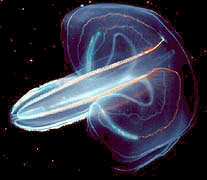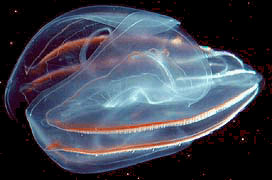Introduction to Ctenophora
 |
Ctenophores, variously known as comb jellies, sea gooseberries, sea walnuts, or Venus's girdles, are voracious predators. Unlike cnidarians, with which they share several superficial similarities, they lack stinging cells. Instead, in order to capture prey, ctenophores possess sticky cells called colloblasts. In a few species, special cilia in the mouth are used for biting gelatinous prey.
The phylogenetic position of ctenophores has been, and still is, in dispute. Ctenophores have a pair of anal pores, which have sometimes been interpreted as homologous with the anus of bilaterian animals (worms, humans, snails, fish, etc.). Furthermore, they possess a third tissue layer between the endoderm and ectoderm, another characteristic reminiscent of the Bilateria. However, molecular data has contradicted this view, although only weakly. Therefore, this is an active area of research.
 |
Until fairly recently, no fossil ctenophores were known. Like most pelagic cnidarians, the bodies of ctenophores are made up mostly of water, and the chances of leaving a recognizable fossil are very slim. Two species of fossil ctenophore have now been found in the Late Devonian, in the famous Hunsrückscheifer slates of southern Germany (Stanley and Stürmer, 1983, 1987). Both owe their preservation to rapid precipitation of pyrite in the tissues, and both are quite similar to living ctenophores in the order Cydippida (the "sea gooseberries.") Other ctenophore-like forms have been found in the Cambrian-age Burgess Shale of the Canadian Rocky Mountains and Chengjiang Formation of Southern China. These forms differ from living ctenophores in several ways, thus obscuring their phylogenetic affinities.
Little is currently known about the basic biology of most ctenophores; indeed, the individual in these pictures has not even yet been formally described and named, despite being large, spectacularly colored, and common. These photographs were made available to the UCMP by Underwater World, Queensland, Australia.
View the World List of Ctenophora species, arranged in a taxonomic classification, or visit the page on Ctenophora at the Tree of Life.
Sources:
- Stanley, G.D., and W. Stürmer. 1983. The first fossil ctenophore from the Lower Devonian of West Germany. Nature 303:518-520.
- Stanley, G.D., and W. Stürmer. 1989. A new fossil ctenophore discovered by X-rays. Nature 327:61-63.
